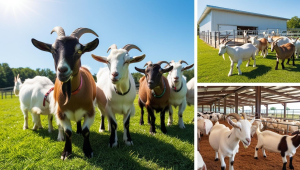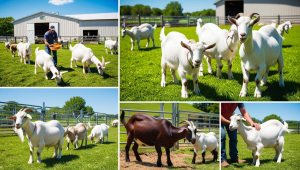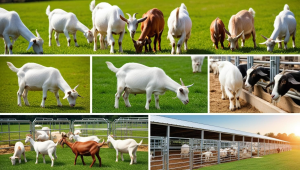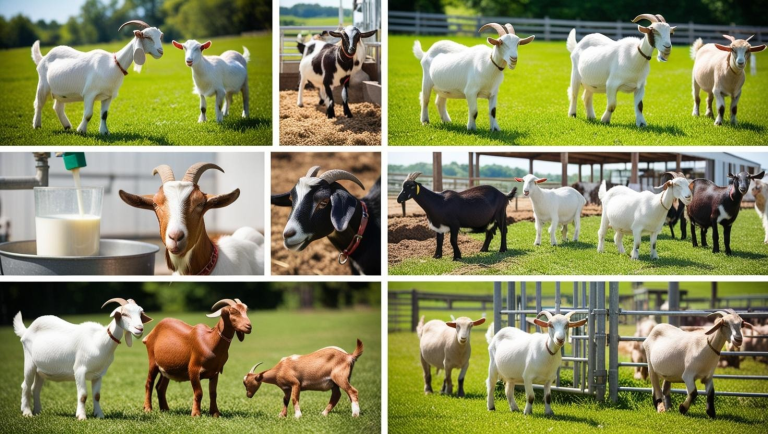Goat farming is a profitable and sustainable agricultural practice that provides both meat and milk to meet growing global demand. Goats are hardy animals that adapt to various climates and require less space and investment compared to cattle. Whether for commercial farming or small-scale production, goats are an excellent choice for livestock farming.
This article covers breeds, housing, feeding, breeding, disease management, and marketing strategies for successful goat farming.
Click HERE to join our WhatsApp group
Benefits of Goat Farming
a. Dual-Purpose Production
Goats provide two major products:
Meat (Chevon): Lean, nutritious, and in high demand worldwide.
Milk: Easily digestible, rich in vitamins, and used for dairy products like cheese and yogurt.
b. Low Investment, High Returns
Requires less space and feed than cattle.
Can thrive on marginal lands where other livestock may struggle.
High reproductive rate – goats kid twice a year, with twins or triplets being common.
c. Climate Adaptability
Can be raised in tropical, arid, or cold regions.
Resistant to many diseases affecting cattle and sheep.

Goat Breeds for Meat and Milk Production
a. Meat Goat Breeds
These breeds grow quickly, have high carcass yield, and produce lean, tasty meat.
Boer Goat (South Africa)
READ ALSO: Leptospirosis in Pigs
Fast-growing, heavy muscling.
Produces 40-50 kg of meat at maturity.
Kiko Goat (New Zealand)
Hardy, disease-resistant, and fast-growing.
Spanish Goat (USA)
Excellent for brush control and adaptable to various climates.
Savanna Goat (South Africa)
Large-framed, high fertility, and excellent carcass yield.
b. Dairy Goat Breeds
These breeds produce high-quality milk with excellent butterfat content.
Saanen (Switzerland)
Produces 3-4 liters of milk/day.
Low butterfat (3%) but high volume.
Nubian (UK, Middle East, North Africa)
Produces 2-3 liters/day with high butterfat (4-5%).
Alpine (France, Switzerland)
Produces 3 liters/day; adaptable to various climates.
Toggenburg (Switzerland)
Produces 2.5-3 liters/day with low butterfat (2-3%).
LaMancha (USA)
Known for long lactation periods and good butterfat content (4%).
c. Dual-Purpose Breeds (Meat & Milk)
Jamunapari (India): Good milk yield and meat quality.
Beetal (Pakistan, India): Produces milk and has excellent meat characteristics.
Barbari (India, Pakistan): Small but efficient in milk and meat production.
READ ALSO: Impact Of Ammonia And Humidity On Poultry
Housing and Management
a. Ideal Housing Conditions
Ventilation: Ensure fresh air and prevent respiratory diseases.
Drainage: Dry flooring to avoid hoof problems and infections.
Space Requirements:
1.5–2 m² per adult goat.
Additional space for young kids.
Bedding: Use straw, sand, or sawdust for comfort.
b. Fencing and Security
Use strong wire fencing (1.5 meters high) to prevent escape.
Protect from predators like dogs, foxes, and wild animals.
Feeding and Nutrition
a. Feeding Meat Goats
Forage-Based Diet (70-80%)
Grasses, shrubs, legumes, and crop residues.
Concentrate Feed (20-30%)
Maize, wheat bran, soybean meal, groundnut cake.
Minerals & Vitamins:
Salt licks and mineral supplements.
READ ALSO:DEBEAKING IN POULTRY FARMING
b. Feeding Dairy Goats
Lactating goats need 3-5 liters of water per day.
High-energy diet: Silage, grains, and oilseeds.
Protein Sources: Alfalfa, soybean meal, or cottonseed cake.
Calcium Supplements: Essential for milk production.
c. Importance of Clean Water
Always provide fresh, clean water for better digestion and milk yield.
Breeding and Reproduction

a. Breeding Management
Goats reach breeding age at 8-10 months.
Estrus cycle: Every 18-21 days, lasts 24-48 hours.
Gestation period: 150 days (5 months).
b. Kidding and Kid Management
Goats can give birth to 1-3 kids per cycle.
Provide warm, dry, and safe conditions after birth.
Colostrum feeding is essential for the first 48 hours.
c. Artificial Insemination (AI)
Improves breed quality and genetic traits.
Allows selection of high-yielding dairy or fast-growing meat goats.
READ ALSO: STUNTED GROWTH IN BROILERS
Disease Management in Goat Farming
a. Common Diseases and Prevention
Disease Symptoms Prevention & Treatment
PPR (Peste des Petits Ruminants)
Fever, nasal discharge, diarrhea
Vaccination
Mastitis. Swollen udder, low milk production. Clean housing, antibiotics
Pneumonia. Coughing, labored breathing. Avoid cold, damp housing
Foot Rot. Lameness, swollen hooves. Trim hooves, dry flooring
Bloat. Swollen stomach, discomfort. Avoid excessive legumes, provide fiber
b. Parasite Control
Deworm goats every 3-4 months.
Rotate grazing pastures to reduce parasite load.
Marketing and Profitability

a. Selling Goat Meat
Meat goats reach market weight (30-50 kg) in 6-12 months.
Sell directly to butchers, restaurants, and supermarkets.
b. Marketing Goat Milk
Process into cheese, yogurt, and butter for higher profits.
Supply to local dairy companies, hotels, and health-conscious consumers.
READ ALSO: TIPS TO PREVENT THEFT ON FARM
c. Export Opportunities
High demand in Middle Eastern, African, and Asian markets.
Certification and quality assurance increase export potential.
Future Trends in Goat Farming
a. Organic and Free-Range Goat Farming
Growing consumer preference for chemical-free, organic products.
b. Value-Added Dairy Products
Goat milk ice cream, kefir, and flavored cheeses are in high demand.
c. Sustainable Feeding Systems
Use of agro-industrial byproducts (brewers’ grains, molasses).
Hydroponic fodder production to ensure year-round feed availability.
Conclusion
Goat farming is a profitable and sustainable business for both meat and milk production. By selecting high-yield breeds, implementing proper nutrition, and managing diseases, farmers can maximize productivity and profitability.
READ ALSO: POULTRY HOUSE VENTILATION
Ventilation is an important factor that controls the productive performance of birds. Poor ventilation leads to low weight and food conversion rate, as well as respiratory diseases that increase the mortality rate, reduce the immunity of birds and make them susceptible to bacterial and viral diseases and eventually develop respiratory disease…
READ ALSO: Ration Balancing for Maximum Productivity
Ration balancing is a critical aspect of livestock nutrition that ensures animals receive the right proportions of nutrients to maintain health, maximize productivity, and optimize feed efficiency. Whether raising dairy cattle, beef cattle, poultry, sheep, or goats, providing a well-balanced diet enhances growth rates, milk yield, reproduction, and overall animal performance…
Click HERE to join our WhatsApp group

